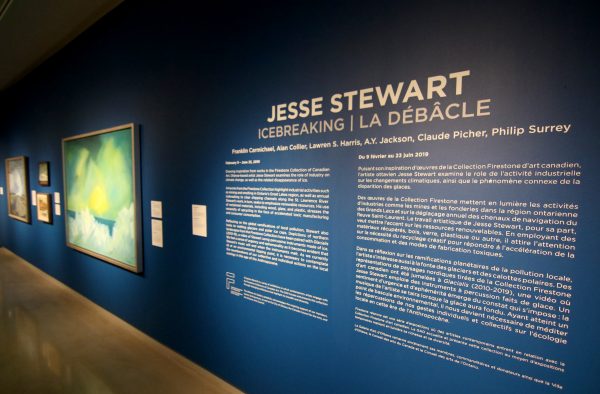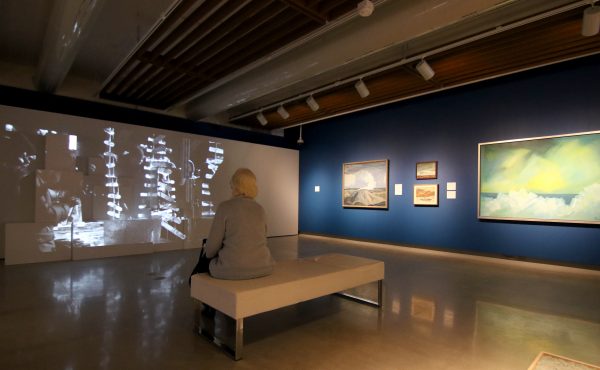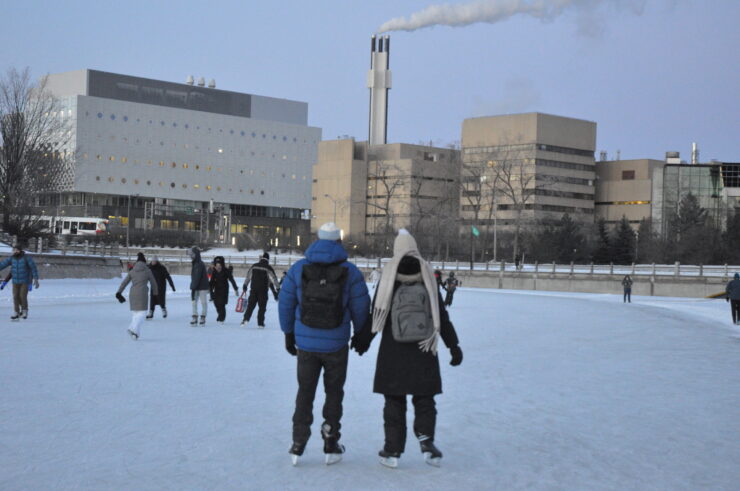Pieces centre around impermanent quality of music, shifting climate and landscape
On Feb. 9, artist and professor Jesse Stewart opened his show Icebreaking to examine climate change’s effects on a shifting landscape at the Ottawa Art Gallery with a packed vernissage and found-object music performance.
Stewart is a visual and sonic artist, a music professor at Carleton, and an adjunct professor in the visual arts department at the University of Ottawa, where he gives guest lectures and provides critiques.
Icebreaking is part of the Firestone Reverb Series, which offers contemporary artists the chance to create works in response to pieces in the Firestone Collection, which collects mainly Group of Seven and other landscape paintings.
“Many of (the paintings) are winter-scapes, and I knew that this would be opening during Winterlude, so I was interested in thinking about and creating a response to these winter-scapes,” said Stewart. “Specifically, I was thinking: what is the response in a time when climate change is radically altering the climate and the landscape.”

The exhibition centres around three main pieces that each analyze landscapes that would have been familiar to the Group of Seven painters and updates them for contemporary audiences. Juxtaposed next to Lawren Harris’ 1920s paintings of the Arctic, is Stewart’s “Best Before,” a map of the melting Arctic made from bread tabs, all with expiration dates visible.
“A lot of the scenes that his paintings depicted look drastically different now because of climate change, so that kind of juxtaposition highlights the deleterious effect that humanity is having on the landscape,” said Stewart.
“The piece with all the little bread tabs, they have an expiration date on them, and our planet also has an expiration date … if humanity continues to have the negative impact that they are having on the planet, that day is coming sooner than we would like.”
The exhibit also features a projection and sound piece from 2010 of a performance on ice percussion instruments at a Toronto winter festival. Stewart’s musical training is in percussion and he often gives performances on found-object or handmade instruments—in this case, instruments made of ice. The ice has an ephemeral quality, said Stewart, that matches the theme of disappearing landscapes in his other art.

“In all of the pieces there is a feeling of impermanence,” said Stewart. “The video that features the music on instruments made of ice, well all those instruments have long since melted, so there’s a kind of impermanence embedded in the materiality of that particular piece of music.”
A map of the Great Lakes is made from skids and glass picked up from the shores of the lakes themselves, a commentary, said Stewart, on the fact that the choices we make down south have serious effects here and in the North.
“I don’t want it to be just about the north, I want it to drive home the point that actions that we take here have an impact—our reliance on plastic, for example, so the connection to industry,” Stewart said. “All of the glass comes from the bodies of water depicted there. But there again it’s thinking of the traces that we make even when we’re discarding things, throwing broken bottles into the lake. We can make ethical, responsible choices here.”
In Icebreaking, Stewart adds another exhibition to the ongoing discourse around the Anthropocene and humanity’s effects on the climate and a changing landscape. Juxtaposed with the earlier Group of Seven works, the immediateness of our changing world is made clear.
Icebreaking runs until June 23, 2019 at the Ottawa Art Gallery. Admission is free.







